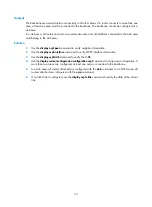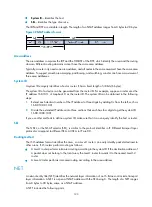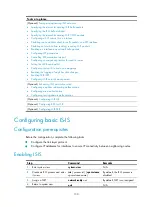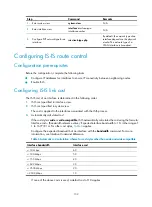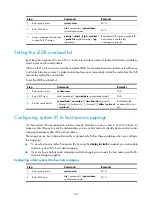
134
To configure a preference for IS-IS:
Step Command
Remarks
1.
Enter system view.
system-view
N/A
2.
Enter IS-IS view.
isis
[
process-id
] [
vpn-instance
vpn-instance-name
]
N/A
3.
Configure a preference for
IS-IS.
preference
{
preference
|
route-policy
route-policy-name
} *
The default setting is
15.
Configuring the maximum number of ECMP routes
Perform this task to implement load sharing over ECMP routes.
To configure the maximum number of ECMP routes:
Step Command
Remarks
1.
Enter system view.
system-view
N/A
2.
Enter IS-IS view.
isis
[
process-id
] [
vpn-instance
vpn-instance-name
]
N/A
3.
Specify the maximum number
of ECMP routes.
maximum load-balancing
number
The default maximum
number depends on the
device model.
Configuring IS-IS route summarization
Perform this task to summarize specific routes, including IS-IS routes and redistributed routes, into a single
route. Route summarization can reduce the routing table size and the LSDB scale.
Route summarization applies only to locally generated LSPs. The cost of the summary route is the lowest
one among the costs of the more-specific routes.
To configure route summarization:
Step Command
Remarks
1.
Enter system view.
system-view
N/A
2.
Enter IS-IS view.
isis
[
process-id
] [
vpn-instance
vpn-instance-name
]
N/A
3.
Configure IS-IS route
summarization.
summary
ip-address
{
mask
|
mask-length
}
[
avoid-feedback
|
generate_null0_route
|
[
level-1
|
level-1-2
|
level-2
] |
tag
tag
] *
By default, route summarization is
not configured.
Advertising a default route
IS-IS cannot redistribute a default route to its neighbors. This task enables IS-IS to advertise a default route
of 0.0.0.0/0 in an LSP to the same-level neighbors. Upon receiving the default route, the neighbors add
it into their routing table.


